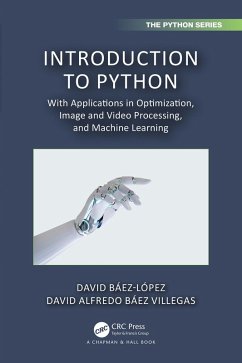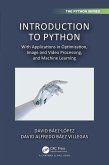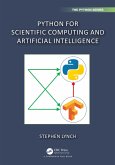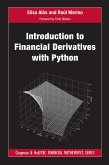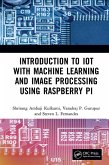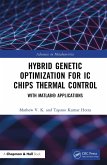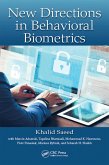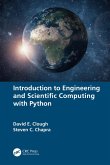Introduction to Python (eBook, PDF)
With Applications in Optimization, Image and Video Processing, and Machine Learning


Alle Infos zum eBook verschenken

Introduction to Python (eBook, PDF)
With Applications in Optimization, Image and Video Processing, and Machine Learning
- Format: PDF
- Merkliste
- Auf die Merkliste
- Bewerten Bewerten
- Teilen
- Produkt teilen
- Produkterinnerung
- Produkterinnerung

Hier können Sie sich einloggen

Bitte loggen Sie sich zunächst in Ihr Kundenkonto ein oder registrieren Sie sich bei bücher.de, um das eBook-Abo tolino select nutzen zu können.
Introduction to Python: with Applications in Optimization, Image and Video Processing, and Machine Learning is intended primarily for advanced undergraduate and graduate students in quantitative sciences such as mathematics, computer science, and engineering. In addition to this, the book is written in such a way that it can also serve as a self-contained handbook for professionals working in quantitative fields including finance, IT, and many other industries where programming is a useful or essential tool.
The book is written to be accessible and useful to those with no prior experience…mehr
- Geräte: PC
- mit Kopierschutz
- eBook Hilfe
![Introduction to Python (eBook, ePUB) Introduction to Python (eBook, ePUB)]() David Báez-LópezIntroduction to Python (eBook, ePUB)59,95 €
David Báez-LópezIntroduction to Python (eBook, ePUB)59,95 €![Python for Scientific Computing and Artificial Intelligence (eBook, PDF) Python for Scientific Computing and Artificial Intelligence (eBook, PDF)]() Stephen LynchPython for Scientific Computing and Artificial Intelligence (eBook, PDF)57,95 €
Stephen LynchPython for Scientific Computing and Artificial Intelligence (eBook, PDF)57,95 €![Introduction to Financial Derivatives with Python (eBook, PDF) Introduction to Financial Derivatives with Python (eBook, PDF)]() Elisa AlòsIntroduction to Financial Derivatives with Python (eBook, PDF)81,95 €
Elisa AlòsIntroduction to Financial Derivatives with Python (eBook, PDF)81,95 €![Introduction to IoT with Machine Learning and Image Processing using Raspberry Pi (eBook, PDF) Introduction to IoT with Machine Learning and Image Processing using Raspberry Pi (eBook, PDF)]() Shrirang Ambaji KulkarniIntroduction to IoT with Machine Learning and Image Processing using Raspberry Pi (eBook, PDF)46,95 €
Shrirang Ambaji KulkarniIntroduction to IoT with Machine Learning and Image Processing using Raspberry Pi (eBook, PDF)46,95 €![Hybrid Genetic Optimization for IC Chips Thermal Control (eBook, PDF) Hybrid Genetic Optimization for IC Chips Thermal Control (eBook, PDF)]() Mathew V. K.Hybrid Genetic Optimization for IC Chips Thermal Control (eBook, PDF)43,95 €
Mathew V. K.Hybrid Genetic Optimization for IC Chips Thermal Control (eBook, PDF)43,95 €![New Directions in Behavioral Biometrics (eBook, PDF) New Directions in Behavioral Biometrics (eBook, PDF)]() New Directions in Behavioral Biometrics (eBook, PDF)44,95 €
New Directions in Behavioral Biometrics (eBook, PDF)44,95 €![Introduction to Engineering and Scientific Computing with Python (eBook, PDF) Introduction to Engineering and Scientific Computing with Python (eBook, PDF)]() David E. CloughIntroduction to Engineering and Scientific Computing with Python (eBook, PDF)97,95 €
David E. CloughIntroduction to Engineering and Scientific Computing with Python (eBook, PDF)97,95 €-
-
-
The book is written to be accessible and useful to those with no prior experience of Python, but those who are somewhat more adept will also benefit from the more advanced material that comes later in the book.
Features
- Covers introductory and advanced material. Advanced material includes lists, dictionaries, tuples, arrays, plotting using Matplotlib, object-oriented programming
- Suitable as a textbook for advanced undergraduates or postgraduates, or as a reference for researchers and professionals
- Solutions manual, code, and additional examples are available for download
Dieser Download kann aus rechtlichen Gründen nur mit Rechnungsadresse in A, B, BG, CY, CZ, D, DK, EW, E, FIN, F, GR, HR, H, IRL, I, LT, L, LR, M, NL, PL, P, R, S, SLO, SK ausgeliefert werden.
- Produktdetails
- Verlag: Taylor & Francis eBooks
- Seitenzahl: 452
- Erscheinungstermin: 2. Juli 2024
- Englisch
- ISBN-13: 9781040040669
- Artikelnr.: 70723015
- Verlag: Taylor & Francis eBooks
- Seitenzahl: 452
- Erscheinungstermin: 2. Juli 2024
- Englisch
- ISBN-13: 9781040040669
- Artikelnr.: 70723015
- Herstellerkennzeichnung Die Herstellerinformationen sind derzeit nicht verfügbar.
David Alfredo Báez Villegas is an electrical engineer with master's degrees in Project Management (École de Technologie Supérieure, Montréal) and Electrical Engineering (Texas A&M University, Texas Tech University). He holds a B.S. in Electronic Engineering from Universidad de las Americas-Puebla, Mexico, and M.S in Electrical Engineering from Texas Tech University and Texas A&M University (TAMU). He worked as an assistant to the Office of International Affairs at TAMU before moving to Montreal, Canada. Since 2015 he has been a consultant in project management.
1.2. The Python programming language. 1.3. Book organization. 1.4.
Algorithms. 1.5. Variables. 1.6. Input and output in Python. 1.7. Programs
in Python. 1.8. Comments in a program. 1.9. Functions in Python. 1.10.
Modules and libraries. 1.11. Operators. 1.12. Alphanumeric variables. 1.13.
Lists. 1.14. Dictionaries. 1.15. Tuples. 1.16. Examples. 1.17. Python
instructions for Chapter 1. 1.18. Conclusions. 1.19. Exercises. 2.
Conditionals and Loops. 2.1. Introduction. 2.2. Conditionals. 2.3. The
conditional if-else. 2.4. Nested Conditionals. 2.5. Exceptions and Errors.
2.6. Loops. 2.7. The while loop. 2.8. The for loop. 2.9. Nested loops.
2.10. The instruction break. 2.11. The instruction continues. 2.12.
Additional examples. 2.13. Python instructions for Chapter 2. 2.14.
Conclusions. 2.15. Exercises. 2.16. Bibliography. 3. Data Structures:
Strings, Lists, Tuples, and Dictionaries. 3.1. Introduction. 3.2. Strings.
3.3. Functions on strings. 3.4. Immutability of strings. 3.5. Lists. 3.6.
Tuples. 3.7. Dictionaries. 3.8. Sets. 3.9. Python Instructions for Chapter
3. 3.10. Conclusions. 3.11. Exercises . 4 Arrays. 4.1. Introduction. 4.2.
Introduction to array. 4.3. Vectors. 4.4. Examples with vectors in Python.
4.5. Matrices. 4.6. Arrays in Python. 4.7. Matrix operations using linear
algebra with numpy. 4.8. Special Matrices. 4.9. Examples. 4.10. Arrays in
Pandas. 4.11. Python instructions for Chapter 4. 4.12. Conclusions. 4.13.
Exercises. 5. Functions. 5.1. Introduction. 5.2. Subprograms. 5.3.
Functions in Python. 5.4. Recursion. 5.5. Anonymous functions or lambda
functions. 5.6. Pass by reference. 5.7. Local and global variables. 5.8.
Keyword and default arguments. 5.9. Variable-length arguments. 5.10.
Additional Examples. 5.11. Python Instructions in Chapter 5 5.12
Conclusions. 5.13. Exercises. 6. Object-Oriented Programming. 6.1.
Introduction. 6.2. The Object-Oriented Programming Paradigm. 6.3. Classes
in Python. 6.4. Example. 6.5. Python instructions for Chapter 6. 6.6.
Conclusions. 6.7. Exercises. 6.8. Selected bibliography. 7. Reading and
writing to files. 7.1. Introduction. 7.2. Writing data to a file. 7.3.
Writing numerical data to a file. 7.4. Data reading from a file. 7.5.
Reading and writing data from and to Excel. 7.6. Reading and writing binary
files. 7.7. Python instructions in Chapter 7. 7.8. Conclusions. 7.9.
Exercises. 8. Plotting in Python. 8.1. Introduction. 8.2. Plots in two
dimensions. 8.3. The package seaborn. 8.4. Other two-dimensional plots.
8.5. Pie charts. 8.6. Multiple figures. 8.7. Three-Dimensional Plots. 8.8.
Python instructions for Chapter 8. 8.9. Conclusions. 8.10. Exercises. 8.11.
References. 9. Optimization. 9.1. Introduction. 9.2. Optimization Concepts.
9.3. General Format of the Optimization Process. 9.4. Optimization with
Python. 9.5. The minimize function. 9.6. Linear programming. 9.7. Quadratic
programming. 9.8. Python instructions for Chapter 9. 9.9. Conclusions.
9.10. Selected bibliography. 10. Image Processing with OpenCV. 10.1.
Introduction. 10.2. Reading and writing images and videos. 10.3. Video
capture and display. 10.4. Binary images. 10.5. Histogram. 10.6. Draw
geometric shapes and text on an image. 10.7. Contour detection. 10.8.
Frequency domain processing. 10.9. Noise addition to images. 10.10.
Morphological image processing. 10.11. Python Instructions in Chapter 10.
10.12. Conclusions. 10.13. Selected bibliography. 11. Machine Learning.
11.1. Types of machine learning systems. 11.2. Gradient descent algorithm.
11.3. Multivariate regression. 11.4. The normal equation. 11.5. The package
scikit-learn. 11.6. Polynomial regression. 11.7. Classification with
logistic regression. 11.8. Unsupervised Learning. 11.9. Clustering using
k-means. 11.10. Python instructions in Chapter 11. 11.11. Conclusions. 12.
Neural networks. 12.1. Introduction. 12.2. A model for a neuron. 12.3.
Activation functions. 12.4. Cost function. 12.5. TensorFlow. 12.6.
Convolutional neural networks. 12.7. A layer of a convolutional filter.
12.8. Python instructions in Chapter 12. 12.9. Conclusions.
1.2. The Python programming language. 1.3. Book organization. 1.4.
Algorithms. 1.5. Variables. 1.6. Input and output in Python. 1.7. Programs
in Python. 1.8. Comments in a program. 1.9. Functions in Python. 1.10.
Modules and libraries. 1.11. Operators. 1.12. Alphanumeric variables. 1.13.
Lists. 1.14. Dictionaries. 1.15. Tuples. 1.16. Examples. 1.17. Python
instructions for Chapter 1. 1.18. Conclusions. 1.19. Exercises. 2.
Conditionals and Loops. 2.1. Introduction. 2.2. Conditionals. 2.3. The
conditional if-else. 2.4. Nested Conditionals. 2.5. Exceptions and Errors.
2.6. Loops. 2.7. The while loop. 2.8. The for loop. 2.9. Nested loops.
2.10. The instruction break. 2.11. The instruction continues. 2.12.
Additional examples. 2.13. Python instructions for Chapter 2. 2.14.
Conclusions. 2.15. Exercises. 2.16. Bibliography. 3. Data Structures:
Strings, Lists, Tuples, and Dictionaries. 3.1. Introduction. 3.2. Strings.
3.3. Functions on strings. 3.4. Immutability of strings. 3.5. Lists. 3.6.
Tuples. 3.7. Dictionaries. 3.8. Sets. 3.9. Python Instructions for Chapter
3. 3.10. Conclusions. 3.11. Exercises . 4 Arrays. 4.1. Introduction. 4.2.
Introduction to array. 4.3. Vectors. 4.4. Examples with vectors in Python.
4.5. Matrices. 4.6. Arrays in Python. 4.7. Matrix operations using linear
algebra with numpy. 4.8. Special Matrices. 4.9. Examples. 4.10. Arrays in
Pandas. 4.11. Python instructions for Chapter 4. 4.12. Conclusions. 4.13.
Exercises. 5. Functions. 5.1. Introduction. 5.2. Subprograms. 5.3.
Functions in Python. 5.4. Recursion. 5.5. Anonymous functions or lambda
functions. 5.6. Pass by reference. 5.7. Local and global variables. 5.8.
Keyword and default arguments. 5.9. Variable-length arguments. 5.10.
Additional Examples. 5.11. Python Instructions in Chapter 5 5.12
Conclusions. 5.13. Exercises. 6. Object-Oriented Programming. 6.1.
Introduction. 6.2. The Object-Oriented Programming Paradigm. 6.3. Classes
in Python. 6.4. Example. 6.5. Python instructions for Chapter 6. 6.6.
Conclusions. 6.7. Exercises. 6.8. Selected bibliography. 7. Reading and
writing to files. 7.1. Introduction. 7.2. Writing data to a file. 7.3.
Writing numerical data to a file. 7.4. Data reading from a file. 7.5.
Reading and writing data from and to Excel. 7.6. Reading and writing binary
files. 7.7. Python instructions in Chapter 7. 7.8. Conclusions. 7.9.
Exercises. 8. Plotting in Python. 8.1. Introduction. 8.2. Plots in two
dimensions. 8.3. The package seaborn. 8.4. Other two-dimensional plots.
8.5. Pie charts. 8.6. Multiple figures. 8.7. Three-Dimensional Plots. 8.8.
Python instructions for Chapter 8. 8.9. Conclusions. 8.10. Exercises. 8.11.
References. 9. Optimization. 9.1. Introduction. 9.2. Optimization Concepts.
9.3. General Format of the Optimization Process. 9.4. Optimization with
Python. 9.5. The minimize function. 9.6. Linear programming. 9.7. Quadratic
programming. 9.8. Python instructions for Chapter 9. 9.9. Conclusions.
9.10. Selected bibliography. 10. Image Processing with OpenCV. 10.1.
Introduction. 10.2. Reading and writing images and videos. 10.3. Video
capture and display. 10.4. Binary images. 10.5. Histogram. 10.6. Draw
geometric shapes and text on an image. 10.7. Contour detection. 10.8.
Frequency domain processing. 10.9. Noise addition to images. 10.10.
Morphological image processing. 10.11. Python Instructions in Chapter 10.
10.12. Conclusions. 10.13. Selected bibliography. 11. Machine Learning.
11.1. Types of machine learning systems. 11.2. Gradient descent algorithm.
11.3. Multivariate regression. 11.4. The normal equation. 11.5. The package
scikit-learn. 11.6. Polynomial regression. 11.7. Classification with
logistic regression. 11.8. Unsupervised Learning. 11.9. Clustering using
k-means. 11.10. Python instructions in Chapter 11. 11.11. Conclusions. 12.
Neural networks. 12.1. Introduction. 12.2. A model for a neuron. 12.3.
Activation functions. 12.4. Cost function. 12.5. TensorFlow. 12.6.
Convolutional neural networks. 12.7. A layer of a convolutional filter.
12.8. Python instructions in Chapter 12. 12.9. Conclusions.
